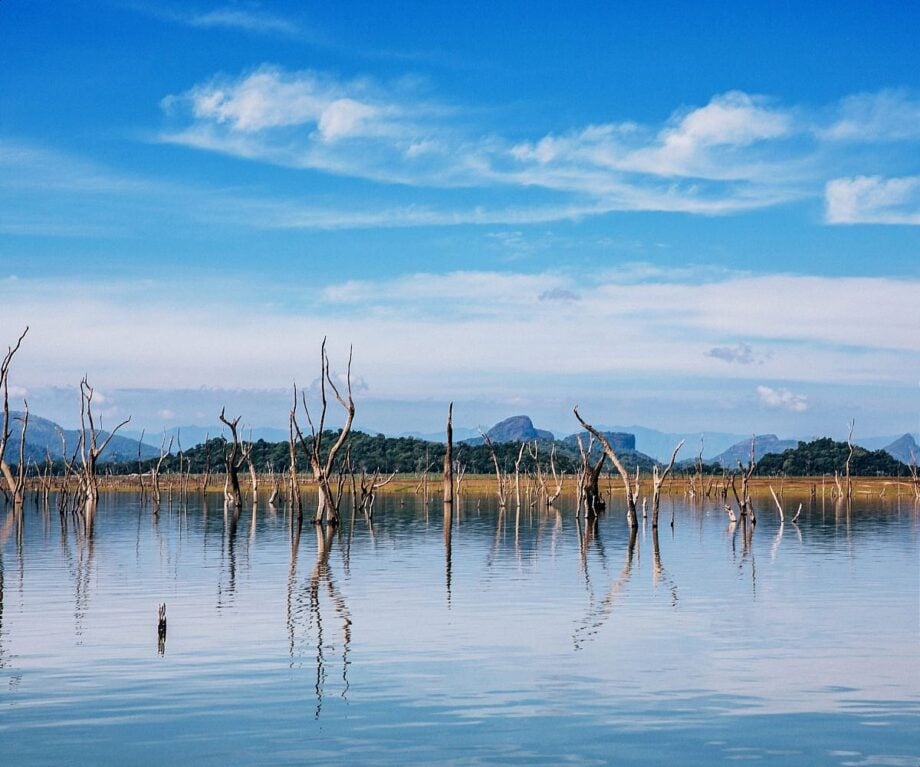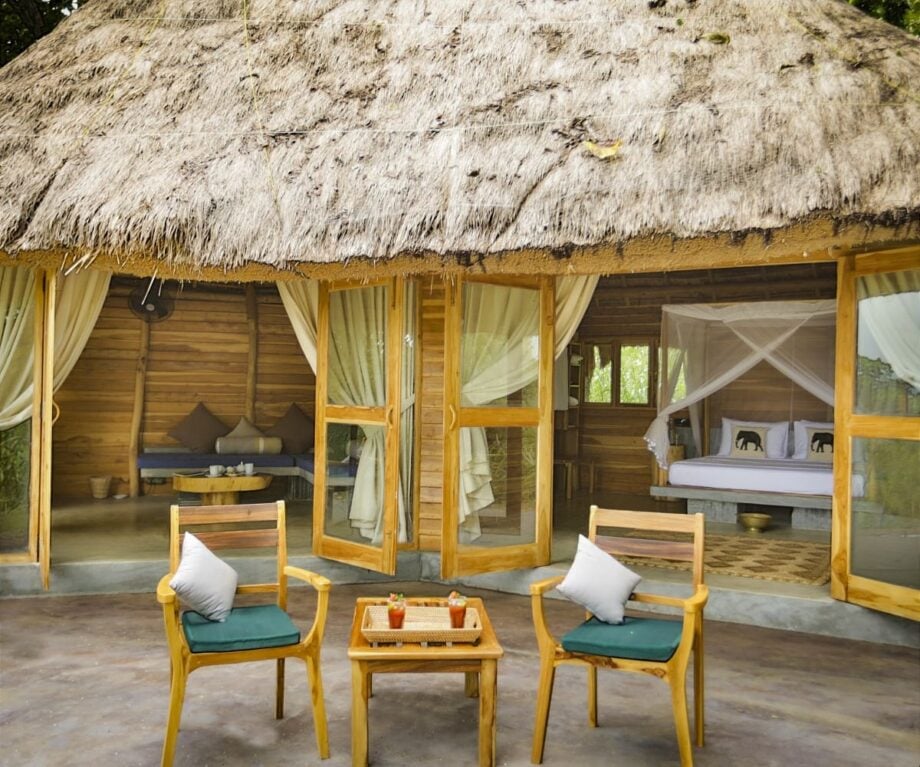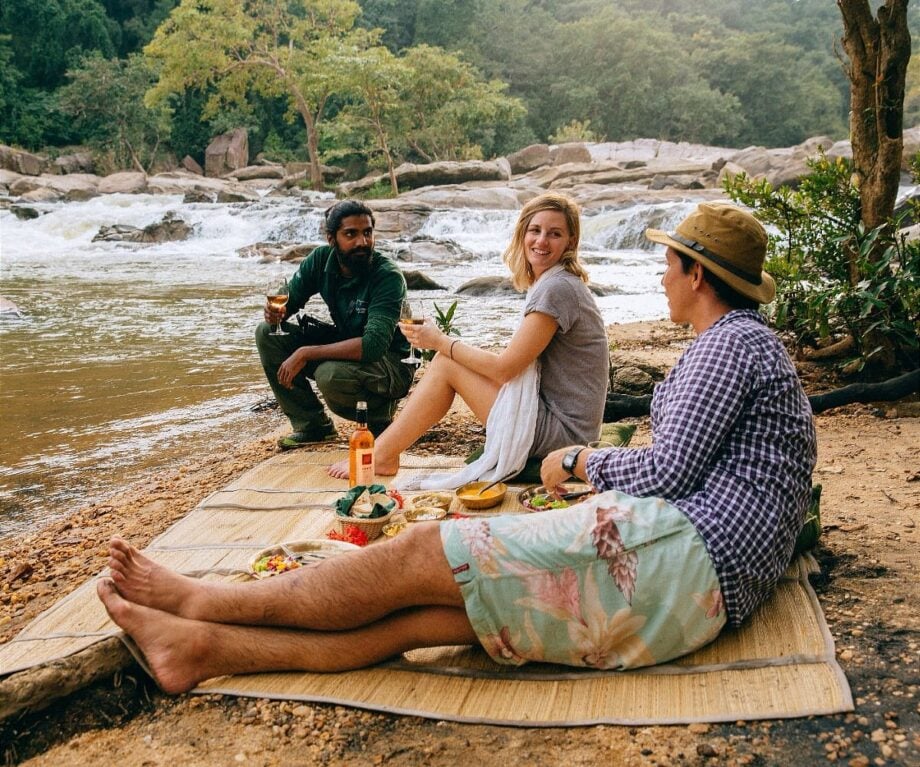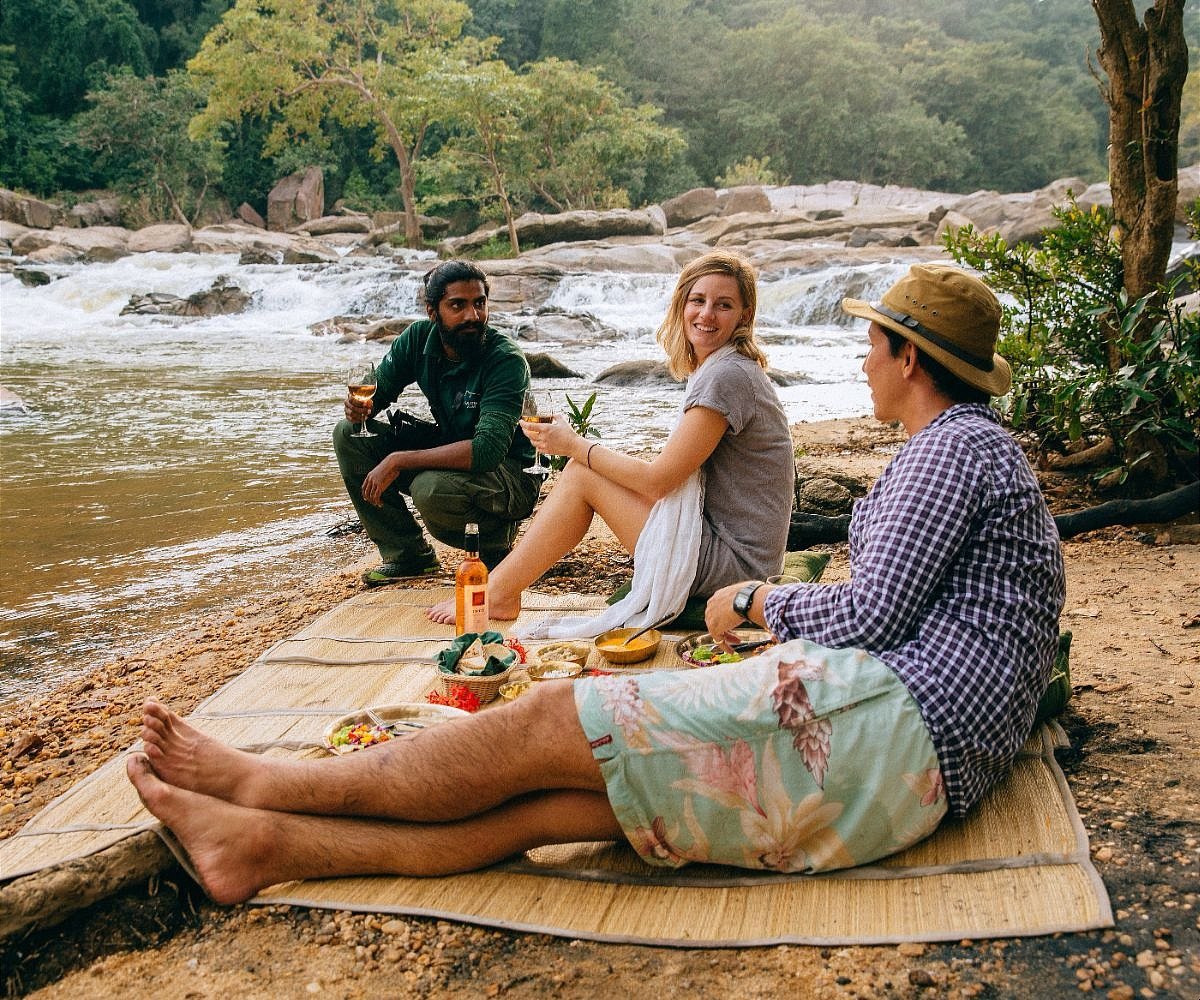Review: Gal Oya Lodge, Galgamuwa, Sri Lanka
Three hours south-east of Kandy, Gal Oya Lodge is the gateway to a National Park that includes Sri Lanka’s largest lake, Senanayake Samudraya. It is the only place in Sri Lanka where you can take a boat safari to see elephants swimming between some of the lake’s 47 islands.

Beyond mobile phone reception, beyond wi-fi and certainly beyond television, Gal Oya Lodge has one foot in the past. You can walk with a Veddha Chief learning how his tribe lived in bygone millennia. Yet, Gal Oya’s environmentally responsible tourism also has one enlightened foot in the future.

Elephants are everywhere. Printed on cushion covers. Carved into tap heads. Threaded through the bed throw. Embossed on the napkin holders and wild elephants amble through the Lodge’s 20 acres. Even the restaurant menus are printed on elephant poo paper.
The welcome
A cool flannel and a glass of lime juice welcomes travellers whist luggage is whisked away to their bungalow.

The bungalow
Within the rooms there are hand-drawn maps of the Gal Oya Lodge’s 20 acres and also the park as a whole.
Around a dozen polished teak tree trunks support a roof thatched with illuk grass to create a charmingly rustic suite.

Craftsmen worked with locally sourced materials to create a grandly spacious suite. A slab of a tree trunk serves as a coffee table in front of a built in L-shaped sofa, large enough to seat a gathering of village elders. Gal Oya is strong on sustainability.

Beneath a whirling ceiling fan, a wide and netted four-poster is the visual centre piece of a simple bedroom. And what could be more appropriate for the bathroom than a rainfall shower?

Two chairs on a patio look out into the luxuriant bush where the cicada chorals never ceases, where the frog orchestra frequently competes.
Facilities
Cooling breezes blow through the open sided A – framed timber building that is home to reception, bar and restaurant.
A small nook of a mezzanine floor hosts the library and a selection of board games. Guide books on birds, butterflies, flowers and wildlife help identify sightings.

With guests coming and going throughout the day, the restaurant is flexible: early breakfasts, late lunches and late dinners are all cheerfully catered for.
A breakfast glass of ginger, tamarind, bees honey and turmeric captures the tropical feel-good mood. Hoppers, a Sri Lankan tradition, top the breakfast menu though an English breakfast is an option too. Lunch might be river fish or a chicken Caesar salad or a pork curry.
Remember that this is Sri Lanka, where people eat curry and rice thrice a day. Every night there’s an opportunity to sample a classic curry served with rice, dahl, vegetables and poppadoms alongside fish, pasta and vegetarian options.

A swimming pool framed by flourishing buffalo grass has views towards towering craggy Monkey Mountain.
Everything you need to plan your trip in 2025
🌟 Luxury hotel deals from Booking
🏡 Vacation rentals from VRBO
✈️ Flights from KIWI
🛫 Private jets from Private Jet Finder
🅿️ Airport parking from ParkVia
🛋️ Airport lounges from Priority Pass
🚖 Airport taxis from Welcome Pickups
🚗 Car rentals from Discover Cars
🚐 Luxury RV rentals from RVshare
🚢 Cruises from Cruise Direct
🛥️ Ferries from Direct Ferries
🎫 Attractions tickets from Tiqets
🏞️ Tours from Viator or GetYourGuide
🛡️ Travel insurance from Safety Wing
🏥 Medical insurance from World Nomads
🧳 Luggage from Case Luggage
🛅 Luggage storage from Stasher
📚 Travel guides from Lonely Planet
📕 eBooks from Kindle Unlimited
🎧 Audiobooks from Audible
🎬 Movies from Prime Video UK
🎵 Music from Amazon Music UK
💶 Travel currency from Wise
📱 SIMs from SimOptions
🌐 VPNs from ExpressVPN or NordVPN
🛂 Visas from iVisa
Location
Take a walk with a naturalist from the Jim Edwards Research Centre to explore the Lodge’s acres where camera traps are set to capture wildlife images.

Recently 20 leopard have been caught on film as well as many elephant, peacock, porcupine and a solitary sighting of an exceptionally rare pangolin.

The resident naturalists also lead bike rides through the forest savannah before taking guests on after-dark wildlife-spotting missions. Whilst the super fit attempt to scale Monkey Mountain.

The local Veddha Chief leads a walk through the forest explaining how his hunter-gatherer tribe thrived for millennia with their intimate knowledge of available food and plants’ medicinal properties. Their animist beliefs and respect for the natural world forbid them from even picking a single leaf unless they have a use for it.
Other nice touches
An evening turndown services pulls the net curtains around the four poster bed and freshens up the bathroom.

Gal Oya Lodge offers a cookery course, in an outdoor kitchen, run by a locals. They pick their fruit and veg on the walk through to the Lodge, using their knowledge to create curries and other local favourites.
Don’t miss the informal and remarkable exhibition of intricate birds’ nests at the Research Centre. Tailorbirds use fine grass to sew two leaves together and then install cobweb bedding for their hatchlings.
The best bit
As dawn breaks, a safari jeep departs for Senanayake Samudraya, Sri Lanka’s largest lake, named after the teardrop island’s first president. Back in 1947 he ordered the creation of the lake as part of an irrigation and energy programme.

Only four boats have a license to serenely cruise through the lake. This safari may include elephants swimming with their trunks raised snorkel-like above the water, hugger-mugger crocodiles and whole islands colonised by birds as their maternity wards. White-bellied eagles, grey heron and comorants scan the lake for their next meal.

Then the boat moors up for an idyllic breakfast or lunch unpacked from an Indian tiffin container.
The cost
Double rooms, including breakfast, begin from US$ 290. This rate includes taxes and service charge.
The final verdict
Far from Sri Lanka’s chaotic towns and cities, Gal Oya is Sri Lanka’s seventh largest park but the least visited. A place of tranquil beauty.

Combining with the Jim Edwards Research Centre, the Gal Oya Lodge has naturalists on hand to provide Attenborough moments as guests explore the park.
Disclosure: Our stay was sponsored by Gal Oya Lodge.
Did you enjoy this article?
Receive similar content direct to your inbox.




I’m trying to get my head round this one. I was thinking of an African safari lodge but in Sri Lanka.
When I read about the boat safari I realised it was something else again.
Whatever it is it seems quite unique to me.
Never heard of the place – and I’ve been to Sri Lanka twice. It must be a long way from the routes that the usual tours take. Sometimes you have to go that extra mile go find the really good places. If I go back again, and 3rd time lucky, I’d like to get to Gal Oya.
You’re right Ben, Gal Oya is off the beaten track, it’s certainly not on the way to any of Sri Lanka’s other sights.
There’s no doubt that it’s worth the journey. There’s plenty to keep you occupied for several days. It’s also a good place to relax by the pool or to sit reading in the evening.
Everything seems to be on a personal and small scale. There’s nothing worse than being part of a big group of 30 or 40. I’ve been on trips with guides where I’ve felt as if I’m back on a school trip.
It may have been because we were at Gal Oya off season but we had a boat to ourselves for the lake safari. The bungalows are nicely detached so for a lot of the time you feel that you’ve got the Lodge to yourself. During the day everyone’s off biking, walking and on the boat safari so if you are back by the pool it is usually very quiet.
This really is a holiday for an active family. Much to my relief our teenage kids are into nature in a big way and they would love it.
You’re right about it being ideal for families. When we stayed there were a few families about. We didn’t see much of them apart from when they were leaving for one of the activities: a bike ride, the Monkey Mountain trek and I know that one family also did the evening wildlife spotting experience.
This is a very different side of Sri Lanka to what I saw. Though I only visited Colombo, Galle and Kandy. It’s much quieter and more natural than what I’ve seen.
Gal Oya Lodge is very different to anything else that I’d stayed in whilst in South Africa. If you’ve read my reviews of Rosyth and Stafford based on tea plantations, Gal Oya was a complete contrast. After the steep contours of the tea plantations we enjoyed walking on flat land for a few days.
This post was quite an eye-opener for me when it comes to Sri Lanka. These vast expanses and big skies were a side of the country that I never knew even existed. Some of those pictures of the lake are more like scenes that you’d expect to see in Africa along the Zambezi. But very relieved to see that there aren’t any hippos. They scare me!
Friends who’ve been to Sri Lanka usually recommend doing some time on the beach at some stage to build in some relaxation.
I’ve never been much of a beach fan. I’m thinking that we could have our chill at time at Gal Oya. I like the idea of doing the boat safari and then spending the rest of the day by the pool.
That map is a great marketing ploy, it looks very attractive.
It must have been fascinating to meet the Veddha tribe. History will probably tells us that we should have done far more to learn from these indigenous peoples as they are so attuned to the natural world around them.
I have had a couple of similar experiences in Africa and it was impressive how the indigenous people were so skilled in finding water in even the most arid of environments. Also they were very good at finding medicinal remedies in the world around them. That knowledge has been built up over millennia and it is tragic to see it being lost.
You probably won’t be surprised to learn that the Veddha are joining the modern world. When they were moved to the village in 1947 there were 500 of them and now there are only about 350. A lot of the younger people leave to find an easier life in Sri Lanka’s towns and cities.
“Beyond mobile reception” would be the biggest selling point for me. There are times when we feel the need to get away.
I know I should be able to switch off without having to physically be beyond connectivity but there are times when you tell the world that you’re beyond communication and everything is a lot simpler.
I appreciate how you seamlessly blend the luxurious aspects of the lodge with its commitment to sustainability. The emphasis on the immersion in nature, from the lake safaris to the charming treehouse accommodations, paints a picture of a retreat that’s both indulgent and in harmony with its surroundings.